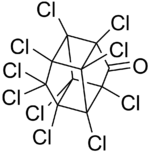Chlorodecone
| Structural formula | |||||||||||||||||||
|---|---|---|---|---|---|---|---|---|---|---|---|---|---|---|---|---|---|---|---|

|
|||||||||||||||||||
| General | |||||||||||||||||||
| Surname | Chlorodecone | ||||||||||||||||||
| other names |
|
||||||||||||||||||
| Molecular formula | C 10 Cl 10 O | ||||||||||||||||||
| External identifiers / databases | |||||||||||||||||||
|
|||||||||||||||||||
| properties | |||||||||||||||||||
| Molar mass | 490.64 g mol −1 | ||||||||||||||||||
| Physical state |
firmly |
||||||||||||||||||
| Melting point |
350 ° C (decomposition) |
||||||||||||||||||
| solubility |
almost insoluble in water (2–4 mg · l −1 at 20 ° C) |
||||||||||||||||||
| safety instructions | |||||||||||||||||||
|
|||||||||||||||||||
| Toxicological data | |||||||||||||||||||
| As far as possible and customary, SI units are used. Unless otherwise noted, the data given apply to standard conditions . | |||||||||||||||||||
Chlordecone is a chemical compound from the group of organochlorine compounds and ketones . Technically pure chlorodecone contains around 5% water and up to 0.1% hexachlorocyclopentadiene .
properties
Chlordecone is very stable in the environment with a half-life of several years.
use
Chlordecone was used as an insecticide and as an intermediate in the manufacture of the insecticide Kelevan . It was introduced in 1958 as a ketone analog by Mirex under the name Kepone and was used in the United States as an insecticide against ants and cockroaches between 1966 and 1975 . Its use was banned in the US in 1975, and in 2009 it was included in the Stockholm Convention on Globally Banned Substances. In 1979, according to a report by the French doctor Dominique Belpomme, the use on the banana plantations in Martinique and Guadeloupe resulted in an above-average number of prostate cancer cases and malformations in newborn children.
Analytical evidence
The chemical-analytical detection in environmental samples, food and animal feed is carried out after suitable sample preparation to separate the matrix and gas chromatographic separation of minor components by high-resolution mass spectrometry techniques such as flight mass spectrometry (Time-Of-Flight mass spectrometry).
Web links
- Health and Safety Guide (HSG) for Chlordecones
- Persistent Organic Pollutants Toolkit - Chlordecone
- US DEPARTMENT OF HEALTH AND HUMAN SERVICES: Toxicological Profile of Mirex and Chlordecone (PDF; 6.8 MB)
Individual evidence
- ↑ a b c d Entry on chlordecone in the GESTIS substance database of the IFA , accessed on February 1, 2016(JavaScript required) .
- ↑ Entry on Chlordecone in the Classification and Labeling Inventory of the European Chemicals Agency (ECHA), accessed on February 1, 2016. Manufacturers or distributors can expand the harmonized classification and labeling .
- ↑ Entry on Chlordecone in the Pesticide Properties DataBase (PPDB) of the University of Hertfordshire , accessed on August 1, 2013.
- ↑ 13th Report on Carcinogens (RoC): Kepone , accessed November 18, 2014.
- ↑ Press Release - COP4 - Geneva, 8 May 2009: Governments unite to step-up reduction on global DDT reliance and add nine new chemicals under international treaty , 2009.
- ↑ World: Population of the Antilles poisoned by pesticides .
- ↑ Pesticides from the Caribbean banana plantations poison people and nature ( Memento from July 10, 2010 in the Internet Archive ).
- ↑ Eric J. Reiner, Adrienne R. Boden, Tony Chen, Karen A. MacPherson and Alina M. Muscalu: Advances in the Analysis of Persistent Halogenated Organic Compounds . In: LC GC Europe . 23: 60-70 (2010).


